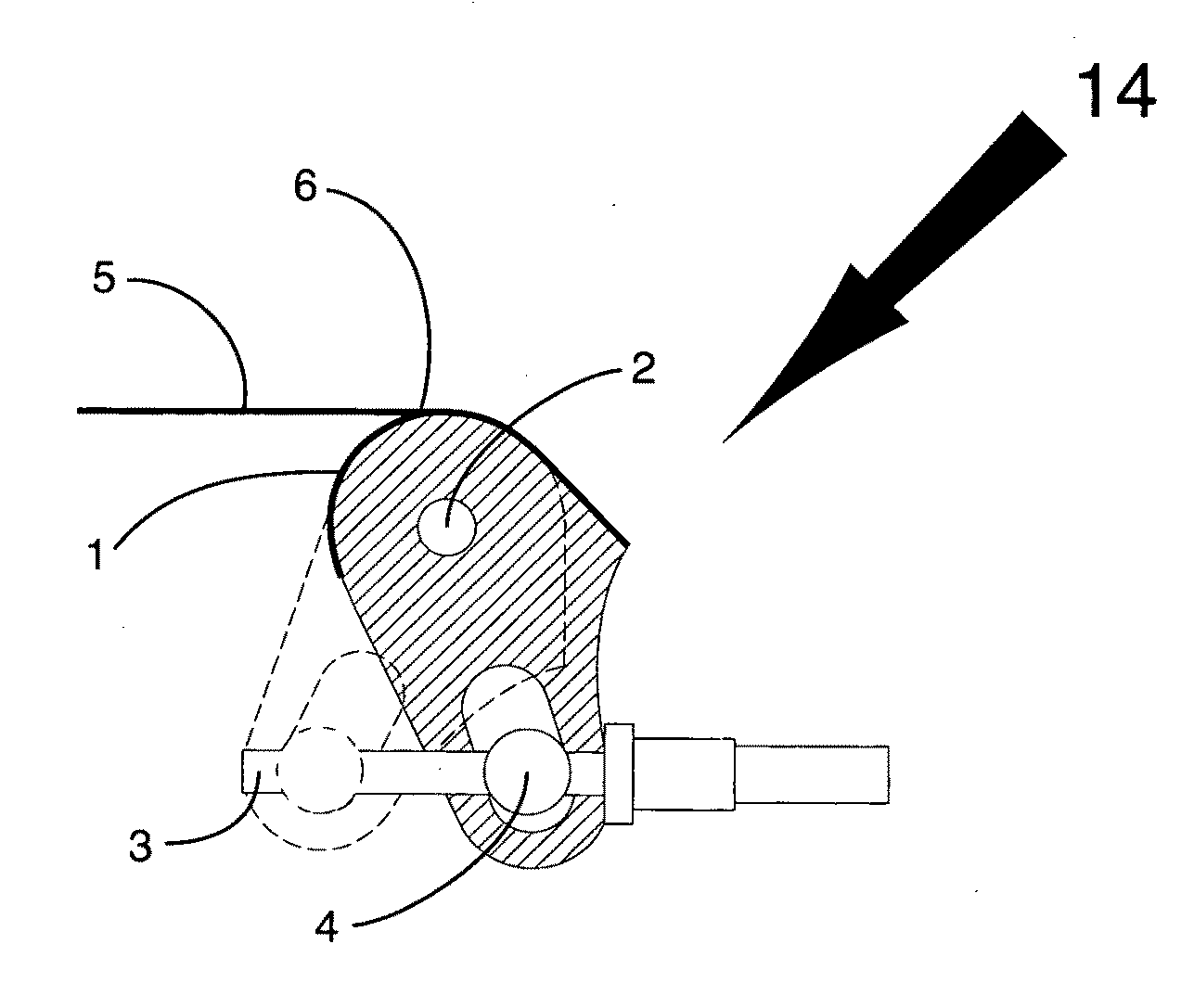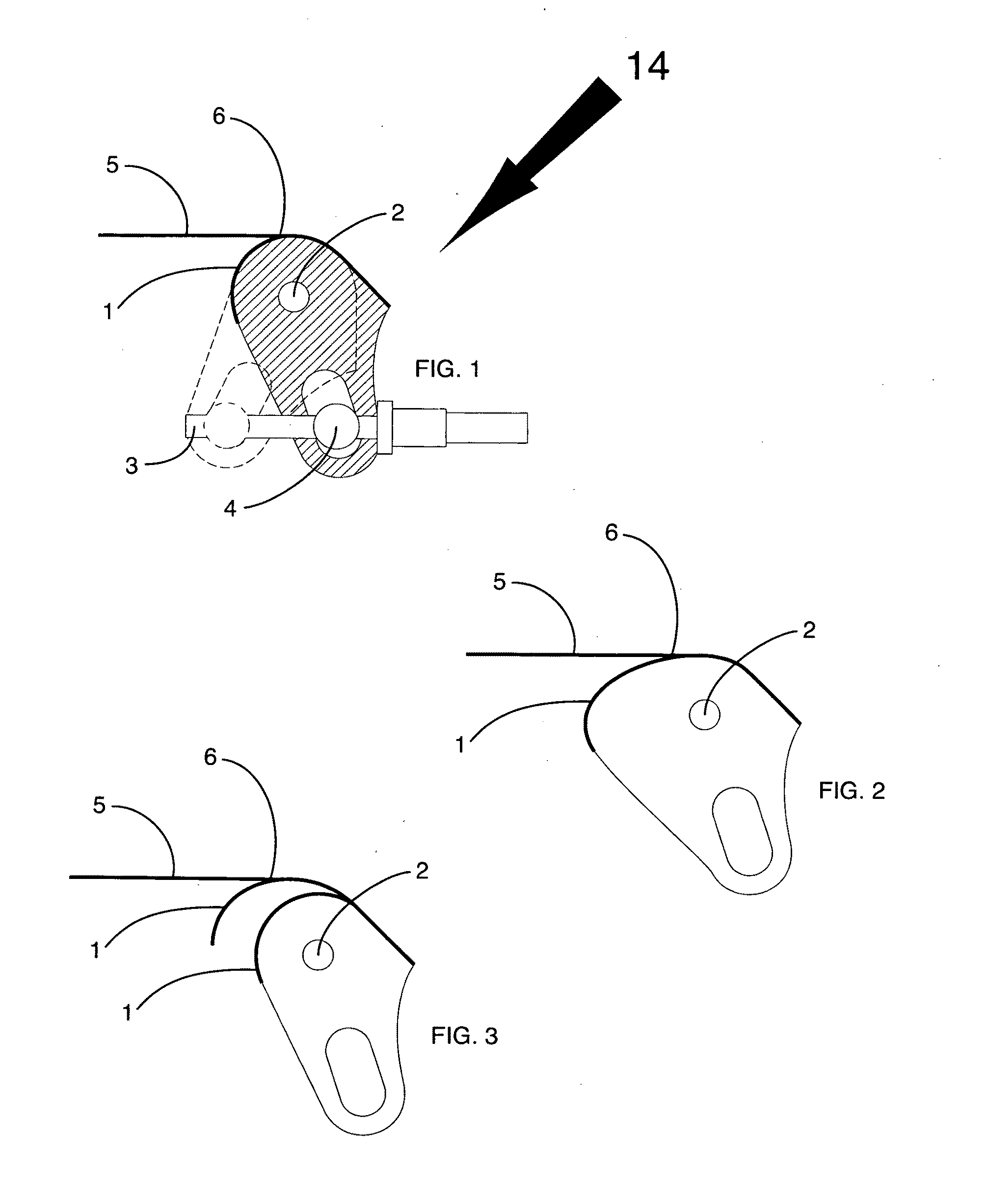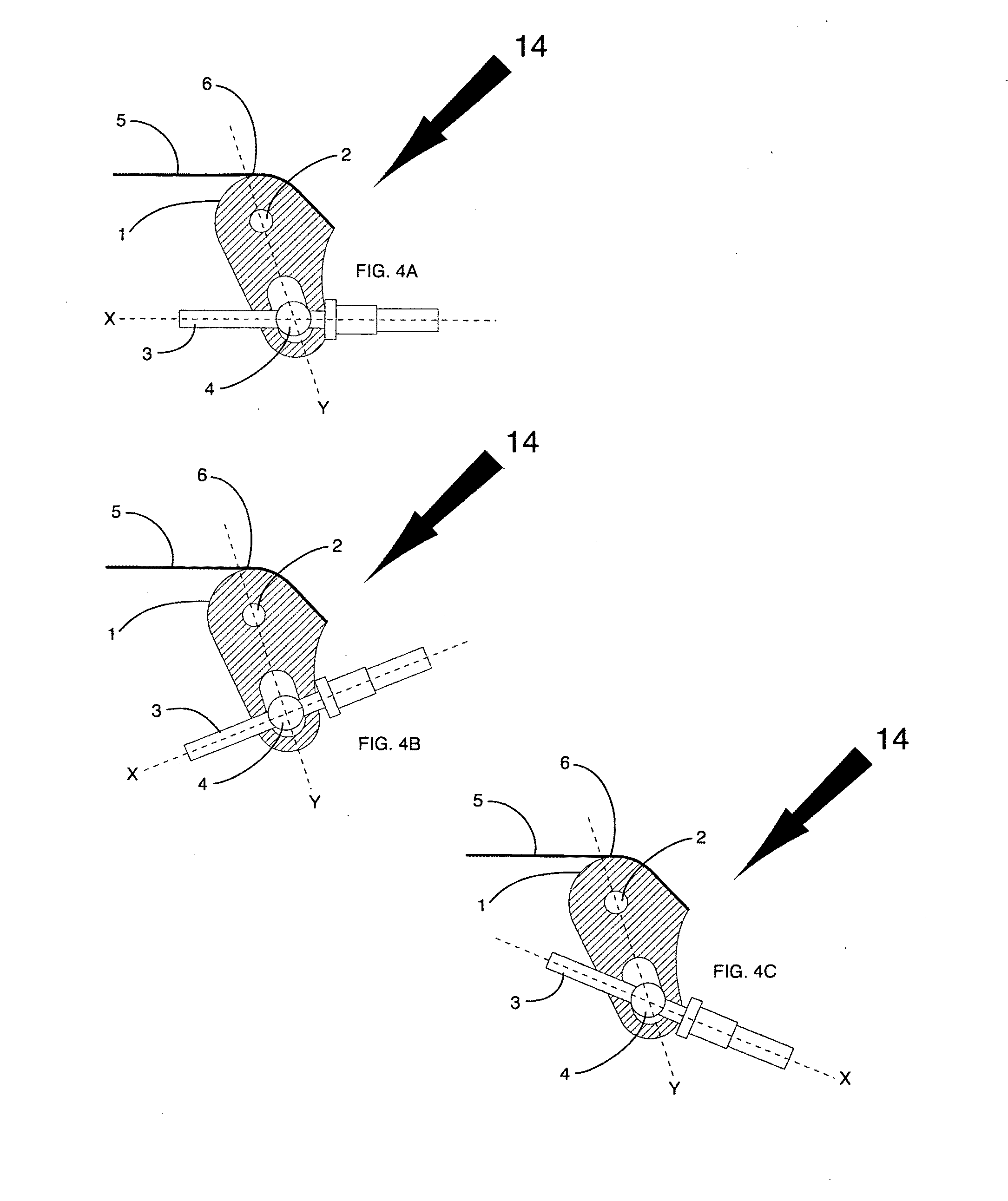Conventional string pitch adjustment control surfaces, i.e., manually manipulated input controls, are undifferentiated string to string, causing errors during attempted tuning adjustments in low light or performance environments.
Collectively mounted units are limited by string center-to-center measurements, requiring considerable dexterity to adjust without disturbing adjacent control surfaces.
Conventional tuning techniques require significant agility to tension a string to pitch.
Use of these proprietary strings is expensive and restrictive for users.
Conventional methods of attaching plain end
metal strings employ a single clamping point, often combined with a dramatic string bend, both of which provide opportunities for string fatigue and
catastrophic failure.
Conventional acoustic instruments using gut or nylon strings, i.e., non-
metal strings—which are more fragile, in comparison to
metal strings—and require a
system of knots or a
capstan arrangement with string windings to anchor or tune provide opportunities for the string to fray or slip, causing breakage or detuning.
These dramatic bends, combined with repeated tensioning and de-tensioning due to tuning and
tremolo or vibrato use, place excessive stress on the strings, often ending in catastrophic destruction of the string.
Conventional string tuning technologies require one or a combination of four mechanical principles, in order to
gain mechanical advantage (leverage) over longitudinal string tension, and are categorized as simple machines:a. Gears used in conventional technologies have significant problems, including manufacturing complexity and gear slip.
Gears, combined with shafts, additionally impart significant longitudinal, tangential, or lateral string displacement.b. Screws used in conventional technologies have significant problems including mechanical
disadvantage, in comparison to other simple machines, due to friction and limited
mechanical advantage determined by thread pitch.
Screws, used alone, additionally impart significant longitudinal, tangential, or lateral string displacement.c. Pulleys used in conventional technologies have significant problems, including manufacturing complexity and longitudinal string stretch.
The greater the length of extra-
harmonic string, i.e., not directly employed between played intonation points, the greater the opportunity for undesired detuning.d.
Levers used in conventional technologies have significant problems, including longitudinal, tangential, and
lateral displacement of the string.
Class 2 and Class 3 levers exhibit additional string deviation and
mechanical instability, compared to Class 1 levers, because the load and fulcrum are not
proximate, or because the force is remote from the fulcrum.
There are significant problems with conventional lever, i.e., lever arm, tuning technologies that include:a. Use of a rotatable ring with a tangentially extended lever arm that requires a pre-tensioning device mounted integral to, or independent of, the lever arm.
The pre-tensioning device adds additional weight, complexity, and extra-
harmonic opportunity for undesired string slip, detuning or
catastrophic failure.b. Use of a
pulley or wheel rotatably mounted in a lever arm requires a pre-tensioning or tuning device mounted integral to, or independent of, the lever arm.
The pre-tensioning or tuning device adds additional weight, complexity and extra-harmonic opportunity for undesired string slip, detuning or
catastrophic failure.
Conventional lever, i.e., lever arm, tuning technologies used as a tuning-bridge have significant problems that include:a. A collective—i.e., a plurality mounted side-by-side on an axle perpendicular to the neck and each in a line—mounted lever arm
assembly is incapable of longitudinal adjustment to compensate for individual string intonation inaccuracies.
Fixed position intonation points are necessarily a compromise solution due to variables including string choice,
thermal expansion due to temperature and
humidity change, instrument manufacture or adjustment, and lead to discordant and undesired pitch errors.b. A lever fixedly mounted to the supporting structure is by definition incapable of longitudinal adjustment to compensate for intonation inaccuracies.c. Collectively mounted levers and fixedly mounted levers are incapable of independent adjustment for string action, i.e., string height above the fingerboard, or for string position relative to the fingerboard and adjacent strings, i.e., string spacing.
This invariability requires compensatory adjustments by components of the
system that are not the rotatable ring, and therefore subject to additional complexity as well as inaccuracies, in relation to the intonation point.
There are significant problems with conventional
tremolo systems that include:a. Fulcrum tremolo systems that include an intonation point detune during pitch change because the location of the string intonation point is independent of the fulcrum point.
Because each string intonation point is necessarily different, the arcs described by multiple strings differ, causing relative string-to-string detuning.
Fulcrum tremolo systems that employ an intonation point independent of the fulcrum mechanism necessarily require extra-harmonic
string length between the appropriate intonation point and fulcrum string contact point and are therefore subject to string stretch, and detuning.
Fixedly mounted levers are by definition not adjustable for string-to-string relative pitch change.
Conventional tremolo technologies are further deficient in the application of spring technologies used to offset longitudinal string tension.
Additionally, as oppositional forces cause the
system to seek equilibrium, longitudinal string movement in relation to the intonation point decreases musical sustain.b. Conventional tremolo spring arrangements constrained parallel to the longitudinal string path have increased susceptibility to harmonic oscillation.c. Spring
noise occurs in tremolo systems as springs elongate or compress.
Thus the act of input causes torsional
distortion to the system, degrading performance and increasing wear.e.
Conventional tremolo systems limited to linear force progression also limit kinesthetic experiences for the musician, thereby stifling creativity.
There are significant problems with conventional technologies that include:a. Both downward force and attachment point
pitch control mechanisms
restrict soundboard and string vibration due to string tension applied directly to the soundboard: the higher the pitch, for a given string, the greater the tension applied to the soundboard.
Additional bracing requires additional material, maintenance and expense, as well as opportunities for joint fatigue or failure.c. Conventional technologies are particularly vulnerable to changes in string tension or
environmental temperature and
humidity.
 Login to View More
Login to View More  Login to View More
Login to View More 


